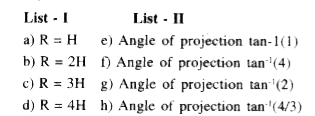The speed of a projectile at its maximum height is √3/2 times its initial speed. If the range of the projectile is n times the maximum height attained by it, n is equal to :
4/3
2√3
4√3
3/4
The correct Answer is:C
To solve the problem, we need to find the value of n such that the range of the projectile is n times the maximum height attained by it, given that the speed of the projectile at its maximum height is √32 times its initial speed.
1. Understanding the Given Information:
- The speed at maximum height is given as v=√32u, where u is the initial speed.
- At maximum height, the vertical component of the velocity vy=0, and the horizontal component vx remains constant.
2. Finding the Angle of Projection:
- The horizontal component of the initial speed is ucosθ.
- At maximum height, the horizontal speed is equal to the speed at that height, hence:
ucosθ=√32u
- Dividing both sides by u (assuming u≠0):
cosθ=√32
- This implies that:
θ=30∘
3. Calculating the Maximum Height (H):
- The maximum height H of a projectile is given by:
H=u2sin2θ2g
- Substituting θ=30∘:
H=u2(12)2g=u24g
4. Calculating the Range (R):
- The range R of a projectile is given by:
R=u2sin2θg
- Using sin2θ=sin60∘=√32:
R=u2⋅√32g=u2√32g
5. Finding the Ratio n:
- We know that R=nH:
u2√32g=n⋅u24g
- Canceling u2g from both sides (assuming u≠0 and g≠0):
√32=n⋅14
- Rearranging gives:
n=2√3
Final Answer:
The value of n is 2√3.
---
- The speed at maximum height is given as v=√32u, where u is the initial speed.
- At maximum height, the vertical component of the velocity vy=0, and the horizontal component vx remains constant.
- The horizontal component of the initial speed is ucosθ.
- At maximum height, the horizontal speed is equal to the speed at that height, hence:
ucosθ=√32u
- Dividing both sides by u (assuming u≠0):
cosθ=√32
- This implies that:
θ=30∘
- The maximum height H of a projectile is given by:
H=u2sin2θ2g
- Substituting θ=30∘:
H=u2(12)2g=u24g
- The range R of a projectile is given by:
R=u2sin2θg
- Using sin2θ=sin60∘=√32:
R=u2⋅√32g=u2√32g
- We know that R=nH:
u2√32g=n⋅u24g
- Canceling u2g from both sides (assuming u≠0 and g≠0):
√32=n⋅14
- Rearranging gives:
n=2√3
The value of n is 2√3.
Topper's Solved these Questions
- KINEMATICS-2BOOK - CENGAGE PHYSICS ENGLISHCHAPTER - KINEMATICS-2EXERCISE - Exercise Multiple Correct
11 Videos
- KINEMATICS-2BOOK - CENGAGE PHYSICS ENGLISHCHAPTER - KINEMATICS-2EXERCISE - Exercise Assertion - Reasoning
5 Videos
- KINEMATICS-2BOOK - CENGAGE PHYSICS ENGLISHCHAPTER - KINEMATICS-2EXERCISE - Exercise Subjective
40 Videos
- KINEMATICS-1BOOK - CENGAGE PHYSICS ENGLISHCHAPTER - KINEMATICS-1EXERCISE - Integer
9 Videos
- KINETIC THEORY OF GASESBOOK - CENGAGE PHYSICS ENGLISHCHAPTER - KINETIC THEORY OF GASESEXERCISE - Compression
2 Videos
Similar Questions
Knowledge Check
The horizontal range of projectile is 4√3 times the maximum height achieved by it, then the angle of projection is
A30∘B45∘C60∘D90∘A projectile is thrown with an initial velocity of (aˆi+bˆj)ms−1. If the range of the projectile is twice the maximum height reached by it, then
Ab=a2Bb=aCb=2aDb=4aThe speed of a projectile when it is at its greatest height is √2/5 times its speed at half the maximum height. The angle of projection is
A30∘B60∘C45∘D0∘
A projectile is thrown with an initial velocity of (aˆi+bˆj)ms−1. If the range of the projectile is twice the maximum height reached by it, then
View SolutionThe potential energy of a projectile at its maximum height is equal to its kinetic energy there. Its range for velocity of projection u is
View SolutionFor a projectile 'R' is range and 'H' is maximum height

View SolutionThe horizontal range of a projectile is 4√3 times its maximum height. Its angle of projection will be
View SolutionThe horizontal range of a projectile is 4√3 times its maximum height. Its angle of projection will be
View Solution
